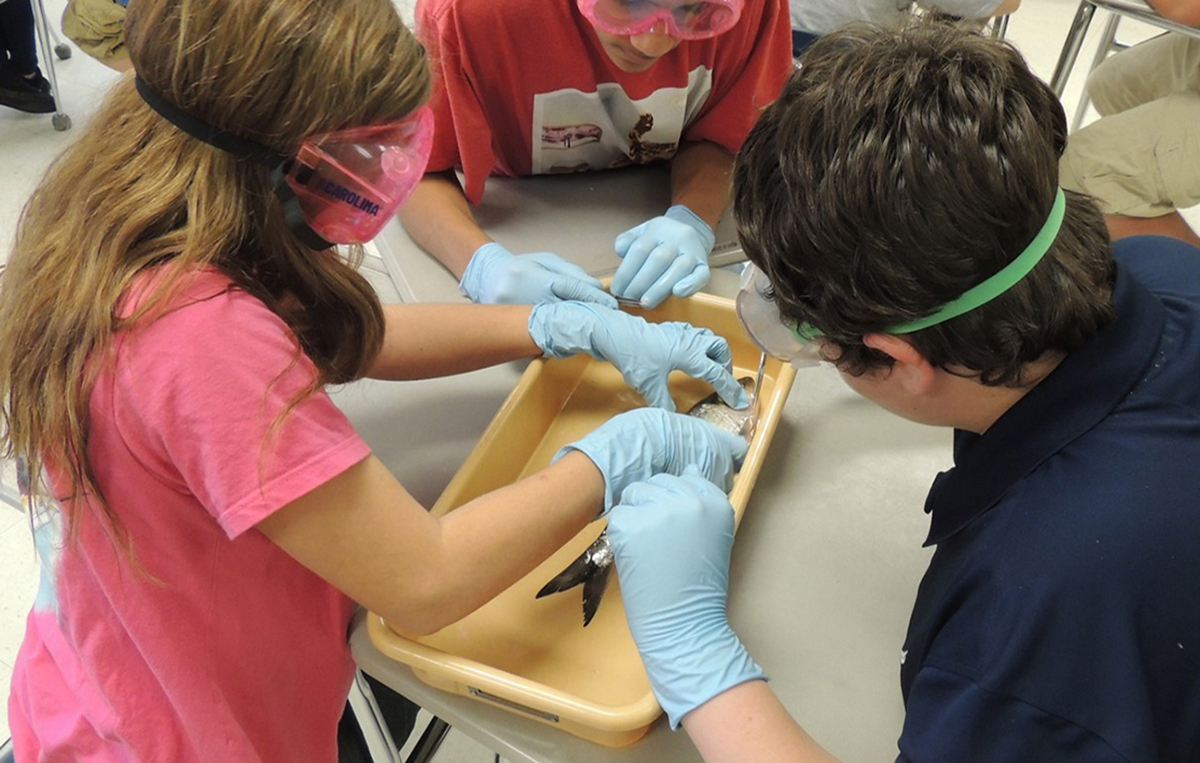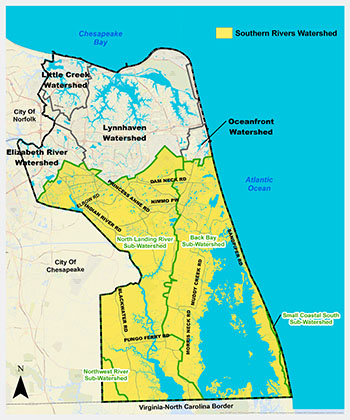
The Albemarle-Pamlico National Estuary Partnership recently awarded $40,000 to two organizations that help teachers educate students about the Albemarle-Pamlico estuarine region in eastern North Carolina and southeastern Virginia.
The Friends of North Carolina Museum of Natural Sciences was awarded $20,000 plus matching funds for its “Shad in the Classroom” program. This program, which began in 2009, helps educators teach about water quality, American shad ecology, riverine and coastal ecosystems, and careers in science. The Friends group is a nonprofit that supports the Raleigh museum.
Supporter Spotlight
Lynnhaven River Now, or LRNow, an environmental organization based in Virginia Beach, will use its $20,000 plus matching funds to create a resource guide and lesson plans for educators in southeastern Virginia and northeastern North Carolina. The guide is expected to include history, natural resources and connections of the region. There are two immersive teacher training experiences planned as part of the project in the southern watersheds of Virginia Beach, which flow into North Carolina’s Pasquotank River Basin and the Albemarle Sound.
“The estuaries of the Albemarle-Pamlico region are a national treasure,” said APNEP Director Dr. Bill Crowell in a statement. “We are very pleased to support these partners working to promote stewardship of the watersheds that flow into Albemarle-Pamlico sounds, including our shared waterways with Virginia.”
The Pasquotank, Chowan and Roanoke basins flow into Albemarle Sound, the Tar-Pamlico and Neuse empty into Pamlico Sound and rivers of the White Oak basin flow to the Albemarle-Pamlico estuary’s southern sounds, including Core, Back and Bogue sounds, according to APNEP.
“The sounds, rivers, creeks, wetlands, and terrestrial areas provide habitat for an abundance of animal and plant species,” Crowell said in a follow-up interview. “People depend on the system for residential and resort development, food, recreation, mining, forestry, agriculture, business, and industry.”
The Environmental Protection Agency, which supports APNEP, provided the funds. APNEP is hosted by the North Carolina Department of Environmental Quality.
Supporter Spotlight
The projects are to be funded for one year and may be funded for up to three years, depending on availability of funds and current program priorities. Crowell said that this is the first year since 2015 with an open call for education and engagement project proposals.
The projects were selected to reach goals in APNEP’s strategic plan, Comprehensive Conservation and Management Plan, and support APNEP’s Memorandum of Understanding, or MOU, with Virginia to address environmental issues in the shared river basins.
“APNEP is a watershed-based program and crosses state lines. Several of our rivers that flow into Albemarle Sound originate in Virginia, so it is important that Virginians know and understand their connections to the communities and environments downstream,” Crowell said. “Building relationships with Virginia-based organizations helps further implementation of our MOU to foster collaboration within the shared waterways of the Albemarle-Pamlico region. Projects like these help elevate recognition of the importance of the significant resources of Albemarle-Pamlico to the regional economy, and its status as the second largest estuary in the United States.”
Shad in the Classroom
Melissa Dowland, manager of teacher education with the Museum of Natural Sciences in Raleigh, and Danielle Pender, the Shad in The Classroom program specialist, explained to Coastal Review in an email that the program offers students an authentic, hands-on experience while assisting with American shad restoration.
Students in elementary, middle and high school learn about American shad’s survival, its cultural and biological importance, ecological connections to other species and habitats, genetics, and careers in fisheries science and management. Teachers incorporate math, social studies, technology, art, literacy and writing.
The program heightens knowledge and awareness in future generations of an important migratory fish, Dowland and Pender said.
“The authenticity this lends to the program has a dramatic impact on student engagement and learning, sometimes providing the first real connections between students and their local river basin,” they said.
During the program, students build a tank, monitor water quality and raise and release juvenile fish in partnership with fisheries biologists from the North Carolina Wildlife Resources Commission and the U.S. Fish and Wildlife Service. Activities include fish dissections, fish printing and water sampling.
“The hands-on approach of these activities allows students to see, touch and explore the subject, helping to engage the students more fully,” they said.
In addition to learning about American shad, the students are helping with ongoing restoration efforts for the species through the North Carolina Wildlife Resources Commission.
The program will be able to continue its work with the grant award from APNEP. The funds will go to supplies for the classroom, staff to coordinate the program and field trips. “In order for the schools to release their larvae into the Neuse River Basin they need to get there. Many of the schools do not have the funding for field trips; therefore, the program reimburses the cost of the buses, gas, and drivers where needed,” they said.
American shad, which can be found in the Atlantic Ocean as far north as the Bay of Fundy in Canada, are important to North Carolina and many other states along the East Coast. An anadromous species, these fish live in the ocean but move into rivers to spawn. When the fish are 3 to 5 years old, they return to the rivers they were born in every spring to spawn. The embryos hatch in the stream and the larvae make their way down to the estuaries as they grow into juvenile fish. In the fall, shad head into the ocean to become adults, they said.
“Due to this anadromous lifecycle, American shad are particularly important in bringing nutrients to and from the ocean and the rivers and they play a significant role in the food web,” Pender and Dowland said. “Shad serve as a food source for many animals living in both inland freshwater and marine environments. Predators of shad include other fishes such as striped bass and king mackerel, bald eagles, bottlenose dolphin, and humans.”
However, American shad face limitations for recovery including poor water quality, insufficient flows, lost or degraded spawning and nursery habitats, recreational or commercial overharvest, industrial impingement and entrainment, and combination of these.
Applications for the Shad in the Classroom are to be available to educators at public and public charter schools this fall.
Lynnhaven River NOW

Jody Ullmann, Pearl School coordinator with Lynnhaven River NOW, told Coastal Review that the organization will use the award to help educators explore the Pasquotank River Basin and Virginia’s Southern Rivers Watershed.
Lynnhaven River NOW, or LRNOW, is a Virginia Beach-based environmental organization working to remove pollutants from the waterways, educate and engage the population of the city, and restore and conserve riparian buffers, forested land, and oyster reefs, according to LRNOW.
After exploring these waters, the teachers will develop resource materials to link Virginia and North Carolina watershed maps. The organization plans to share all Virginia resources with North Carolina educators.
“This award has given us the means to take on the dream of getting teachers on the water and participating in an immersive adventure that will change how they feel about the Albemarle/Pamlico Sound and the lands that drain to this amazing estuarine system,” she said.
False Cape State Park, Back Bay National Wildlife Refuge and university researchers and environmental educators from both states are to work together on the project.
With the MOU signed between Virginia and North Carolina, one of the goals of the project “is to build relationships with resources in North Carolina, both people and places, that might be able to be called upon to help students with research, zoom into a classroom or form partnerships with schools,” Ullmann said.
Ullmann explained that though the city’s schools focus on the Chesapeake Bay watershed and problems the area faces, two-thirds of Virginia Beach land drains to the Albemarle and Pamlico sounds in North Carolina.
“It is important for the teachers to see and learn about this watershed firsthand, so that they can go back into the classrooms and develop activities and programs that help the students understand that not only are they living in a special watershed, just as fragile and important as the Chesapeake Bay, but that their actions have a direct effect on the quality of the water downstream,” she said.
Crowell told Coastal Review that these projects support one or more objectives in APNEP’s strategic plan by communicating the importance of stewardship and offering volunteer opportunities, providing and promoting outdoor experiences, providing environmental education training opportunities for educators in the region and increasing public understanding of the relationship between ecosystem health and human health advisories relating to water, fish and game.
“The projects are intended to increase citizen stewardship, volunteerism, and environmental literacy within the Albemarle-Pamlico region,” he said. “The goal of the projects is that through targeted education, engagement, and communications efforts, APNEP and its partners will encourage citizens to reduce their environmental impacts and provide meaningful opportunities to protect and restore the ecosystem.”
In the long run, supporting programs like these leads to a more knowledgeable public, Crowell said, adding that these connections with natural world give collective efforts to preserve and protect value and real meaning.
“Educational efforts help foster the desire for citizens to directly assist through volunteering and supporting our partner organizations that promote stewardship of our waterways, and also help advocate for policy and decision makers to direct resources towards monitoring ecosystem health and protecting and restoring our watersheds and estuarine systems,” he said.







